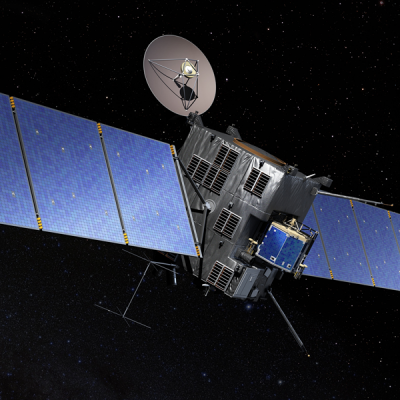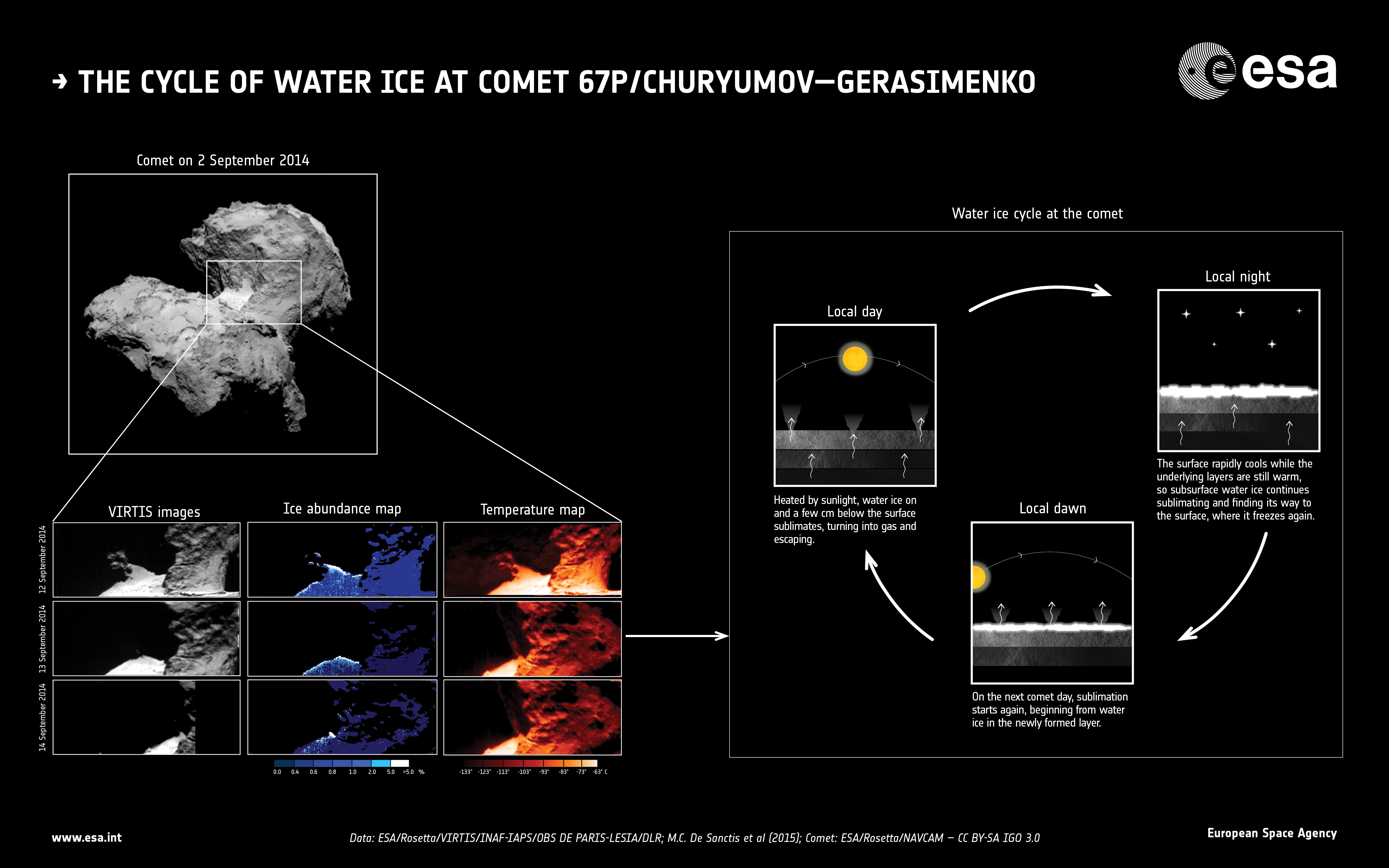Arrived at destination in August 2014, Rosetta study closely, since one year, the 67P/Tchourioumov-Guerassimenko comet, monitoring the way that its activity increases with the months. The comet reached the perihelion, the point nearer to the Sun on its orbit of 6 and a half year, on August 13, 2015, and now goes back towards the outside of the Solar System.
One of the questions studied by comets' specialists is about the physical processes which feed the degasing activity. The idea is to understand how water-ice is extracted from the ground to feed water vapor to the coma.
According to a strudy presented in "Nature" , a team of scientists observed water-ice appears and disappears daily on a region of the comet. These observations were supplied by VIRTIS instrument, the visible, infrared and thermal imaging spectrometer of Rosetta, in September 2014 when the comet was at about 500 millions kilometers from the Sun. The team studied a set of VIRTIS data centered on Hapi, a region located on the "neck" of the comet which was one of the most active part of the core during this period.


This result, coming from an international collaboration, involves the participation of six French scientists from LESIA (Laboratoire d'Etudes Spatiales et d'Instrumentation en Astrophysique) and iPAG (Institut de Planétologie et d’astrophysique de Grenoble). The LESIA supplied VIRTIS high resolution channel and is responsible for the observations of this instrument.
When the Sunlight heat the frozen core of the comet, water-ice contained in the ground sublimates. The resulting water vapor escape the surface, bringing with it solid dusts: together, this mixture of gas and dusts feed the coma and the bright queue wich make the comets observable from the Earth. During a day, which lasts a little more than 12 hours, the different regions are under varied lighting conditions.
The data suggest that during the day, the water-ice sublimates in the first centimeters of the ground, becoming gas and migrating towards the surface. At night, the surface cool down very fast; the deeper layers, which accumulated the Sun's heat, cool down slowlier and stay warmer.
Water-ice at a few centimeters under the surface then continues to sublimate and migrates towards the surface through this poreous ground. As soon as this "underground" water vapor reach the cold surface, it freezes again, creating a layer of fresh ice on this region.
When the Sun rizes again over this region, the molecules in the new ice layer sublimates immediately and a new cycle begins.
"We suspected such a water ice cycle might be at play at comets, on the basis of theoretical models and previous observations of other comets but now, thanks to Rosetta's extensive monitoring at 67P/Churyumov–Gerasimenko, we finally have observational proof,” says Fabrizio Capaccioni, VIRTIS principal investigator at INAF-IAPS in Rome, Italy.
From these data, it is possible to estimate the relative abundance of water ice with respect to other material. Down to a few cm deep over the region of the portion of the comet nucleus that was surveyed, water ice accounts for 10–15% of the material and appears to be well-mixed with the other constituents.
"It is possible that many patches across the surface were undergoing the same diurnal cycle, thus providing additional contributions to the overall outgassing of the comet," adds Dr Capaccioni.
The scientists are now busy analysing VIRTIS data collected in the following months, as the comet’s activity increased around the closest approach to the Sun.
« Rosetta is capable of tracking changes on the comet over short as well as longer time scales, and we are looking forward to combining all of this information to understand the evolution of this and other comets » concludes Matt Taylor, ESA Rosetta Project Scientist.
Reference of the article
Maria Cristina de Sanctis, et al., (2015), The diurnal cycle of water ice on cometary nuclei, Nature, 525, 500–503.
Contacts
- Scientific responsible: Stéphane Erard, VIRTIS instrument French responsible
- Solar System Responsible: Francis Rocard